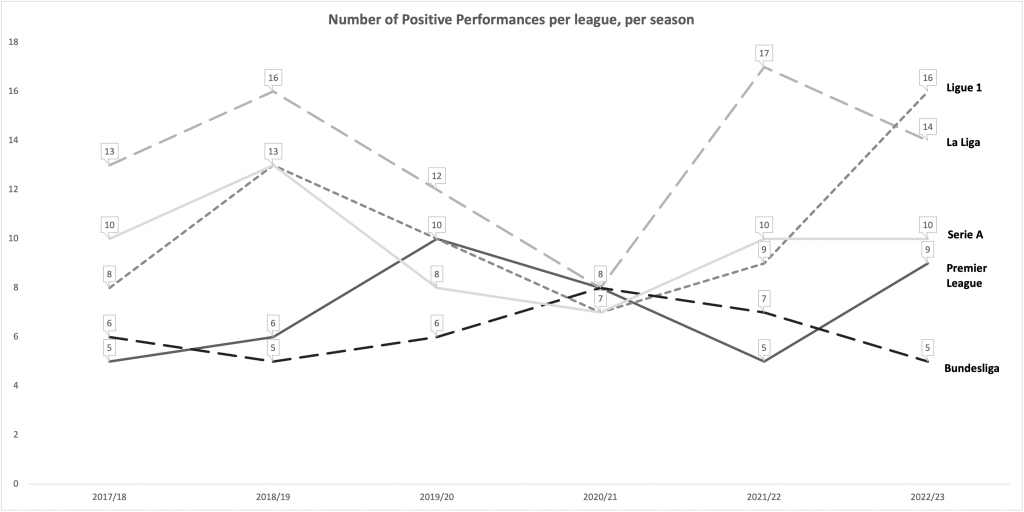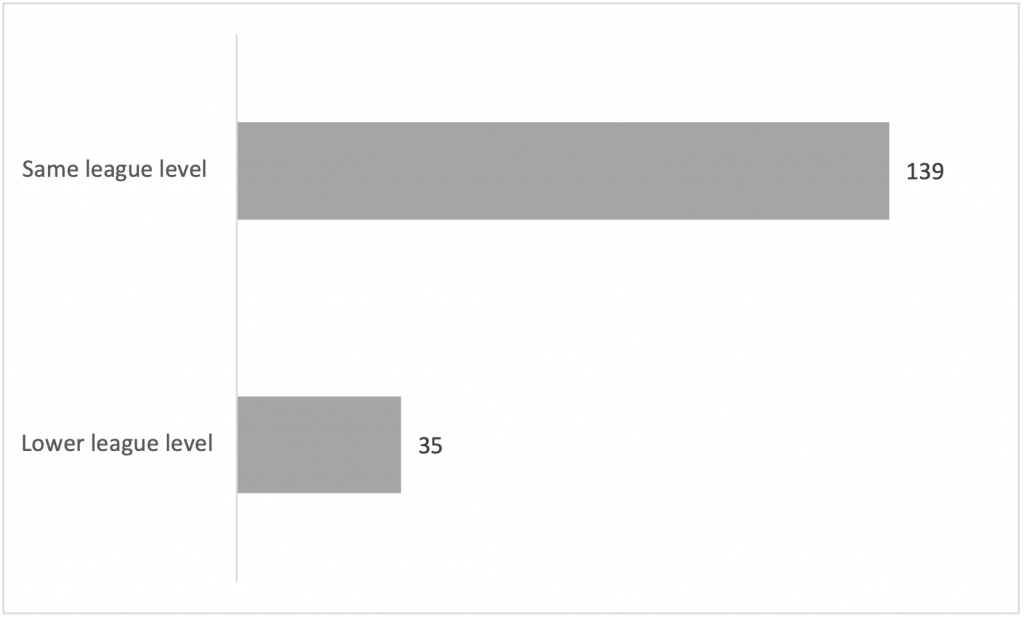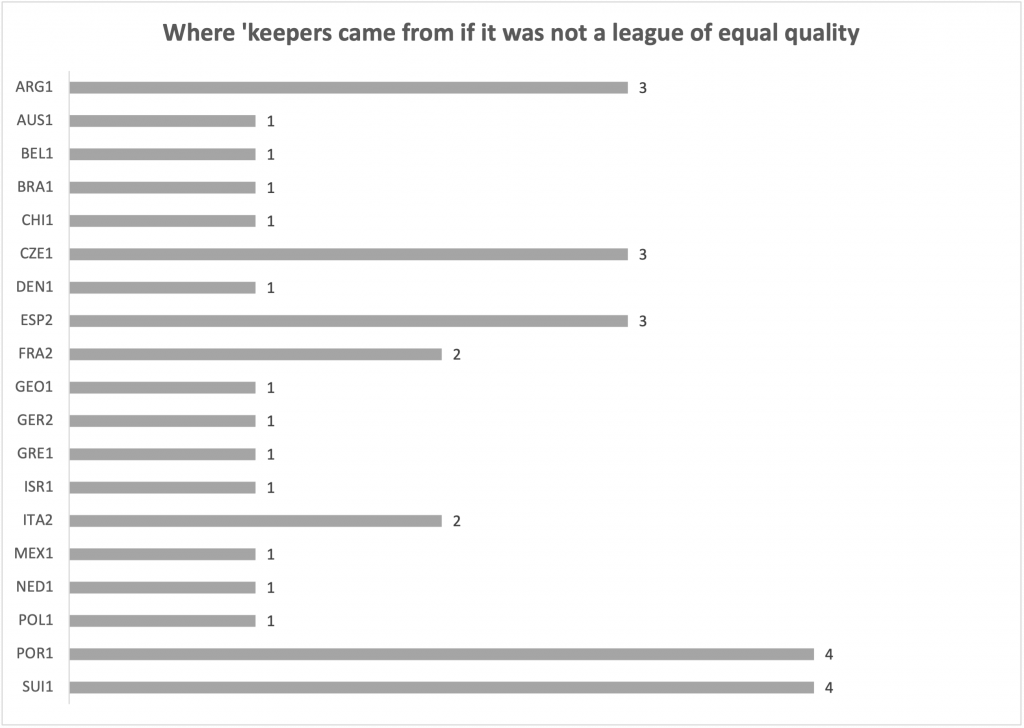Alex Stewart looks back at six seasons’ worth of performance data and asks are we getting value from our goalkeepers (and why is David Soria so underrated?)
Goalkeeping is one of the hardest parts of the game to analyse, and it seems like many transfers for goalkeepers result in failure. While the position may not command the heady fees of today’s defensive midfielders, clubs should always be looking for efficiencies in the market and data is crucial to uncovering such insights.
We wanted to dig into transfer data to see if anything might be inferred from a goalkeeper’s transfer history about their future performances.
Analysing the last six full seasons of Europe’s top five leagues, 2017/18-2022/23, using FBref.com, we recorded every goalkeeper whose league PSxG-GA/90 was 0.00 or greater, so every ‘keeper who in any given season prevented more goals than expected, or at least broke even. We looked at /90 metrics to ensure that minutes played were factored in.
PSxG is probably the best metric for assessing pure shot-stopping ability and, while there are many other factors to be taken into consideration when assessing a goalkeeper (for example, distribution), the key function of the role is still to stop the opposition scoring (this is probably worth a whole article or series on its own, actually).
The reason we chose goalkeepers who had performed positively was because we wanted to answer questions around which set of circumstances might favour positive goalkeeping performances. Eduin Latimer looked in a previous piece at which metrics correlate most with team or individual performance, using transfers as a factor. This piece aims to build on that, to a degree, by looking at transfer information itself.
In the first sift, 281 seasons of ‘positive’ goalkeeping performance were recorded (that is, a positive PSxG-GA/90). That does not mean 281 different goalkeepers, though. Some ‘keepers appear in the list more than once, and some of those more than once for more than one club. Five players appeared five times out of the six possible seasons: Alisson for one season at AS Roma and four at Liverpool, Getafe’s David Soria, Jan Oblak of Atletico Madrid, Real Madrid’s Thibault Courtois, and Juventus’ Wojciech Szczesny.
Interestingly, Soria has never been capped for Spain and cost a grand total of €3 million (all values in this piece are taken from Transfermarkt), while clearly showing himself one of the best ‘keepers in Europe five seasons in a row.
A further nine keepers appeared four times, with a few, like Mike Maignan and Keylor Navas, appearing for more than one club.
In addition to names and performance data, we collected the following: whether a player had played outside of their country of nationality before the transfer (this was listed as no if the transfer was to a different nation, but it was the first), the league they were bought from, whether that league was another top five league (or of similar quality if moving from a second tier side to another, before winning promotion) or a lower level, the cost, and whether the move was a loan.
This should help us answer the following questions:
Which leagues do players producing positive performances come from?
Have more or fewer players who have produced positive performances played abroad before arriving at the club where that positive performance occurs?
Do players tend to produce positive performances having moved up a league tier or stayed at the same level?
And, what the associated cost and/or loan status of such moves were.
Firstly, it’s worth noting that La Liga has the greatest number of positive performances, 80, although that doesn’t necessarily mean the most players (remember, a performance is a player season); next was Ligue 1, with 63, them Serie A with 58, the Premier League, 43, and the Bundesliga, 37. It should be also be noted that the Bundesliga has two fewer teams.

When looking solely at individuals, LaLiga topped the list with 43 keepers (Rui Silva appearing for two clubs), Ligue 1 was next with 40 (with Lafont, Samba, Mendy, and Mandanda doing it for two clubs, and Benjamin Lecomte doing it for Montpellier more than once but with a permanent move elsewhere in between), Serie A with 31 (four players doing it at two clubs), the Premier League 23 (with three doing it at two clubs), and the Bundesliga 22 (with two doing it at two clubs).
Of 281 performances, there were 174 players with one season at one club that was positive (plus one oddity, Lecomte, who has had three positive seasons at Montpellier, but the latter of which was after being sold to Monaco and having two less successful loan spells in Spain; for this reason he has been counted twice in the 174).
In addition, 28 of those goalkeepers had positive seasons at more than one club, and`81 had more than one positive season, either at one club or two. There was no ‘keeper who managed positive seasons at more than two clubs.
Now let’s answer some questions. Although we have data for all positive seasons, as this is focussing on transfer data, we will only look at the closest positive season to a transfer, which means that some players appear twice if they have registered positive seasons for more than one club. Also, there may have been some gap between the transfer and the positive season (in some instances, there may also have been loan spells in between, especially in Serie A, the effect of which is not really possible to gauge with this level of data collection; sorry!)
Have more or fewer players who have produced positive performances played abroad before arriving at the club where that positive performance occurs? It appears to make no discernible difference: 86 positive player seasons were with no experience aboard beforehand, while 87 did have some. This includes a few players, like Lecomte, who had a season abroad in between spells. Interestingly, when looking at all 281 performers, the numbers are 140 and 141, suggesting that even multiple seasons at one club makes no difference.
However, where you buy your goalkeeper, or rather what level they played at before, is absolutely key.
Here, the data are unequivocal: 139 of those player seasons occurred after a transfer from a league considered equivalent quality or, at least, equivalent tier (i.e., Championship to Serie B; this set also includes players who have moved up the youth system and stayed at that team, of which there are 13 including players like Kepa, Anthony Lopes, and Gianluigi Donnarumma; Lopes is something of a curio having recorded an excellent four positive seasons, all at the club where he came through the ranks and where he has never left). This youth product information is important, too, because it highlights the likelihood of a keeper making at least one move their career; if only 13/139 players had a positive season at the club where they came through the ranks, it’s also obvious that 126 transferred, which is thus the far more likely outcome for a player in their career.
So, in 80% of positive performances, the player has transferred directly from a club in one of the top five European leagues, although there may be a gap of a few seasons before they achieved that positive performance.

But, what of the 20%?
This group had an average PSxG-GA/90, when counting just the first season after the move, of 0.128, too, compared to 0.107 for those bought from a league of equal quality (or a youth product). For outright PSxG-GA it was 4.03 versus 3.27. That shows fairly strongly that players plucked from lesser leagues have stronger positive performances in the first season that counts. Looking at all seasons that count for each player, that changes a little: the lower quality league acquisitions drop to an average PSxG-GA/90 of 0.118, and 3.81 outright, versus 0.105 and 3.23 for the other group. Both groups got worse (it is possible, although unlikely I think, that seasons have been subject to different iterations of the PSxG model). The decline is a little steeper for new arrivals, but it’s probably more about reverting to some overall mean of goalkeeping abilities. Nonetheless, taking a punt on players from a lower league does, on average, yield slightly better performances.
The lower quality league group includes some big names, too: Alisson, although only for his season at Roma, Nice stalwart Walter Benitez, Ederson, Jan Oblak, and some lesser known but obviously high-quality players like Jonas Omlin (pictured above), who had three positive seasons in a row at Montpellier.
As it happens, Montpellier are one of a handful of clubs with a positive season performance for each of the six seasons (with Lecomte, Omlin, and Rulli), while PSG are the club with the most qualifying performances, and most keepers. Four players had positive performance seasons for PSG, Areola, Buffon, Donnarumma, and Navas, and for each the season was shared with another ‘keeper (we took 10 games as a minimum but, in actual fact, every PSG keeper played at least 17 league games in a season)
Interestingly, the three players who moved from the Czech top tier, Koubek, Dubravka, and Pavlenka, two came from Sparta Prague and one from Slavia (Pavlenka), while from Portugal, Ederson and Oblak were bought first by Benfica, while Maximiano came through Sporting’s renowned youth system; only Rui Silva was from a team not one of the traditional big three in Portugal, in this case CD Nacional. As for Switzerland’s cohort, Yann Sommer, Jonas Omlin and Tomas Vaclik were from Basel, while Mory Diaw came from Lausanne. So it seems like even if players are coming from lower quality leagues, those leagues are still the first tier in their nation, and the clubs from which the players are coming are almost always among the biggest clubs in that league (once again a lesson, too, that if Benfica have scouted and acquired a player from abroad, they are likely to be pretty great). It can not only be assumed that these clubs have the finances to buy more promising players, but they probably have a more robust scouting system and potentially more and/or better specialist coaches, thus improving players and readying them for the step up. Also, crucially, these players are more likely to feature in continental competition and therefore be exposed to higher quality opposition and, probably, attract more interest from scouts than players only appearing in lower quality league fixtures.

What about cost? The 34 players bought from lower quality leagues cost, on average, €4.2m, compared with €5.3m on average for the others. This means that you could be picking up a little more in performance output for a little less in fees by shopping lower down the levels, but it happens far less often (and therefore maybe carries more risk).
What is remarkable for goalkeeping fees in general is the distribution. Most players who recorded positive seasons had moved to the club where they had that season on a free.

Of the player seasons we looked at, only 22 of 173 were loan spells, or 12.7%, although we didn’t collect data on how many starters were loanees overall. And with regards to loans, Alex Meret (Napoli), Guglielmo Vicario (Empoli), Luigi Sepe (Salernitana, who also had two positive seasons on loan at Parma) and Jeremias Ledesma (Cadiz) all had a positive season on loan at a club, and then a positive season after that club had acquired them permanently (Bartomiej Dragowski was bought by Fiorentina, had a positive season out on loan at Empoli, and then returned to Fiorentina and had positive season subsequently). But buying a player outright who does well on loan for a club is no guarantee of performance replication, which could indicate something about incentives while on loan as well.
When looking at overall expenditure on ‘keepers, the average levels are remarkably low, which makes sense given the distribution described above. The Premier League spends the most, on average, per ‘keeper just as they do every position. But it is still less than the average cost of ‘keepers with positive PSxG-GA seasons. Interestingly, ‘keepers tend not to leave LaLiga (as shown by the repeat seasons in our dataset as well), but when they do, they have generated the biggest net positive spend by some margin in the period we looked at.

So why the cost disparity? It is, in part, because to be part of our data set you need to be a regular starter (i.e. have started at least 10 games) and they are naturally deemed more valuable than reserves and third choice keepers, many of whom will move on a free. The very, very large fees paid for some starters also drive up the average of our data set, while they are smoothed out among the much larger group of players. Interestingly, the top 10 most expensive ‘keepers of all time all happened in the period we have considered, and the only one not to appear in the list is Andre Onana: he is currently negative for Manchester United and was for his one season at Inter, although he had three positive seasons at Ajax.

This shows that ‘keepers who command huge transfer fees do, at least for one season, prevent more goals than they should.
But our research has also shown that many ‘keepers prevent roughly the same amount of goals having cost nothing. Indeed, the free keepers prevented 0.107 goals per 90, the ones who cost something prevented 0.115. The difference is the equivalent to 0.3 of a goal in a 38 game season.
That is not to say that other factors are not hugely important. Ederson, Neuer, Alisson, and others cost huge amounts in part because of their skill with the ball at feet. And there is real value for the teams that can afford such fees as the trend in elite football has been to include ‘keepers more in build-up, and so the teams who want to play that way are also most likely to be the ones who can afford it.
But, as our research has shown, ‘keepers are about as likely to record a positive shot-stopping season as not, regardless of how much they cost.
So, some suggestions for goalkeeping transfers, based purely on shot-stopping ability:
- You do not need to spend a lot of money, especially as shot-stopping is a fairly volatile metric: a free goalkeeper is about as likely to be positive as an expensive one
- ‘Keepers overwhelming produce positive seasons having already played for another club at the same level first (this may include ‘keepers bought from second tier sides who get promoted with the new club)
- If you do buy a ‘keeper from a lower level, there is a strong likelihood the move will work better if they come from a dominant team in that league, especially if it is one with a strong reputation for scouting (especially in specific regions).
- In general, keepers from lower leagues are on average £1.1 m less expensive, but produce slightly better performances. However, the moves happen far less frequently and could therefore be assumed to be riskier (or work out because the ‘keeper is so obviously outstanding: Oblak, Ederson, Alisson, and so on)
- ‘Keepers who have played on loan and done well can replicate that performance, but there is no guarantee
- The average age of all ‘keepers with positive performances, including repeats, is 28.1 years.
For large clubs with deep pockets, there are likely to be other factors. But for clubs with less transfer heft, scouting for 26-28 year olds coming to the end of a contract with another top five club is about as likely to produce a positive season for goals prevented as splashing the cash, while gambling on a lower level talent, but one who has come through a dominant team with a strong reputation may also be worth doing.
A few further things: we did not look at negative performances, so the next steps for this kind of research would be to see what, if any, patterns exist there, while diving into preceding performances at the clubs ‘keepers moved from would also yield interesting data. It would be good to see, for example, whether a positive season at a lower level club is more prevalent for players who then move, or whether there’s a greater rate of failure for lower level players in terms of negative performances.
Header image copyright IMAGO/Uwe Kraft














